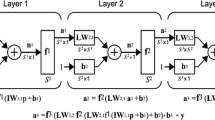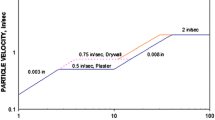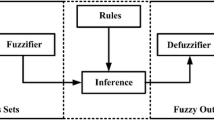Abstract
One of the most significant environmental issues of blasting operations is ground vibration, which can cause damage to the surrounding residents and structures. Hence, it is a major concern to predict and subsequently control the ground vibration due to blasting. This paper presents two artificial intelligence techniques, namely, adaptive neuro-fuzzy inference system (ANFIS) and artificial neural network for the prediction of ground vibration in quarry blasting site. For this purpose, blasting parameters as well as ground vibrations of 109 blasting operations were measured in ISB granite quarry, Johor, Malaysia. Moreover, an empirical equation was also proposed based on the measured data. Several AI-based models were trained and tested using the measured data to determine the optimum models. Each model involved two inputs (maximum charge per delay and distance from the blast-face) and one output (ground vibration). To control capacity performances of the predictive models, the values of root mean squared error (RMSE), value account for (VAF), and coefficient of determination (R 2) were computed for each model. It was found that the ANFIS model can provide better performance capacity in predicting ground vibration in comparison with other predictive techniques. The values of 0.973, 0.987 and 97.345 for R 2, RMSE and VAF, respectively, reveal that the ANFIS model is capable to predict ground vibration with high degree of accuracy.

















Similar content being viewed by others
References
Ambraseys NR, Hendron AJ (1968) Dynamic behavior of rock masses: rock mechanics in engineering practices. Wiley, London
Basheer IA, Hajmeer M (2000) Artificial neural networks: fundamentals, computing, design, and application. J Microbiol Meth 43:3–31
Bi R, Schleier M, Rohn J, Ehret D, Xiang W (2014) Land slide susceptibility analysis based on ArcGIS and artificial neural network for a large catchment in three gorges region. China. Environ Earth Sci 72(6):1925–1938
Bounds DG, Lloyd PJ, Mathew B, Waddell G (1988) A multilayer perceptron network for the diagnosis of low back pain. In: IEEE international conference on neural networks, vol 2, pp 481–489
Bureau of Indian Standard (1973) Criteria for safety and design of structures subjected to underground blast. ISI Bulletin, IS–6922
Ceryan N, Okkan U, Kesimal A (2013) Prediction of unconfined compressive strength of carbonate rocks using artificial neural networks. Environ Earth Sci 68(3):807–819
Davies B, Farmer IW, Attewell PB (1964) Ground vibrations from shallow sub-surface blasts. Engineer 217:553–559
Dehghan S, Sattari GH, Chehreh CS, Aliabadi MA (2010) Prediction of unconfined compressive strength and modulus of elasticity for Travertine samples using regression and artificial neural. New Min Sci Technol 20:0041–0046
Dowding CH (1985) Blast vibration monitoring and control. Prentice-Hall, Englewoods Cliffs, pp 288–290
Dreyfus G (2005) Neural networks: methodology and application, 2nd edn. Springer, Berlin
Duvall WI, Petkof B (1959) Spherical propagation of explosion generated strain pulses in rock. USBM Rep Invest 5483:21
Ebrahimi E, Monjezi M, Khalesi MR, Jahed Armaghani D (2015) Prediction and optimization of back-break and rock fragmentation using an artificial neural network and a bee colony algorithm. Bull Eng Geol Environ. doi:10.1007/s10064-015-0720-2
Engelbrecht AP (2007) Computational intelligence: an introduction. Wiley, New York
Fisne A, Kuzu C, Hüdaverdi T (2011) Prediction of environmental impacts of quarry blasting operation using fuzzy logic. Environ Monit Assess 174:461–470
Fu Y, Zhao Y, Zhang Y, Guo T, He Z, Chen J (2013) GIS and ANN-based spatial prediction of DOC in river networks: a case study in Dongjiang, Southern China. Environ Earth Sci 68(5):1495–1505
Ghasemi E, Ataei M, Hashemolhosseini H (2013) Development of a fuzzy model for predicting ground vibration caused by rock blasting in surface mining. J Vib Control 19(5):755–770
Ghoraba S, Monjezi M, Talebi N, Moghadam MR, Jahed Armaghani D (2015) Prediction of ground vibration caused by blasting operations through a neural network approach: a case study of Gol-E-Gohar Iron Mine, Iran. J Zhejiang Univ Sci A doi:10.1631/jzus.A1400252
Ghosh A, Daemen JK (1983) A simple new blast vibration predictor. In: Proceedings of the 24th US Symposium on Rock Mechanics, Texas, USA, pp 151–161
Gordan B, Jahed Armaghani D, Hajihassani M, Monjezi M (2015) Prediction of seismic slope stability through combination of particle swarm optimization and neural network. Eng Comput. doi:10.1007/s00366-015-0400-7
Grima MA, Bruines PA, Verhoef PNW (2000) Modeling tunnel boring machine performance by neuro-fuzzy methods. Tunn Undergr Sp Technol 15(3):260–269
Hajihassani M, Jahed Armaghani D, Sohaei H, Tonnizam Mohamad E, Marto A (2014a) Prediction of airblast-overpressure induced by blasting using a hybrid artificial neural network and particle swarm optimization. Appl Acoust 80:57–67
Hajihassani M, Jahed Armaghani D, Marto A, Tonnizam Mohamad E (2014b) Ground vibration prediction in quarry blasting through an artificial neural network optimized by imperialist competitive algorithm. Bull Eng Geol Environ. doi:10.1007/s10064-014-0657-x
Hecht-Nielsen R (1987) Kolmogorov’s mapping neural network existence theorem. In: Proceedings of the First IEEE International Conference on neural networks. San Diego CA, USA, pp 11–4
Hornik K, Stinchcombe M, White H (1989) Multilayer feedforward networks are universal approximators. Neural Netw 2:359–366
Hudaverdi T (2012) Application of multivariate analysis for prediction of blast-induced ground vibrations. Soil Dyn Earthq Eng 43:300–308
Hush DR (1989) Classification with neural networks: a performance analysis. In: Proceedings of the IEEE international conference on systems Engineering Dayton Ohia, USA, pp 277–80
Iphar M, Yavuz M, Ak H (2008) Prediction of ground vibrations resulting from the blasting operations in an open-pit mine by adaptive neuro-fuzzy inference system. Environ Geol 56(1):97–107
Isik F, Ozden G (2013) Estimating compaction parameters of fine-and coarse-grained soils by means of artificial neural networks. Environ Earth Sci 69(7):2287–2297
Jahed Armaghani D, Hajihassani M, Mohamad ET, Marto A, Noorani SA (2013) Blasting-induced flyrock and ground vibration prediction through an expert artificial neural network based on particle swarm optimization. Arab J Geosci. doi:10.1007/s12517-013-1174-0
Jahed Armaghani D, Tonnizam Mohamad E, Momeni E, Narayanasamy MS, Mohd Amin MF (2014) An adaptive neuro-fuzzy inference system for predicting unconfined compressive strength and young’s modulus: a study on main range granite. Bull Eng Geol Environ. doi:10.1007/s10064-014-0687-4
Jang RJS (1993) Anfis: adaptive-network-based fuzzy inference system. IEEE Trans Syst Man Cybern 23:665–685
Jang RJS, Sun CT, Mizutani E (1997) Neuro-fuzzy and soft computing. Prentice-Hall, Upper Saddle River, p 614
Kaastra I, Boyd M (1996) Designing a neural network for forecasting financial and economic time series. Neurocomputing 10:215–236
Kanellopoulas I, Wilkinson GG (1997) Strategies and best practice for neural network image classification. Int J Remote Sens 18:711–725
Khandelwal M, Singh TN (2006) Prediction of blast induced ground vibrations and frequency in opencast mine-a neural network approach. J Sound Vib 289:711–725
Khandelwal M, Singh TN (2007) Evaluation of blast-induced ground vibration predictors. Soil Dyn Earthq Eng 27(2):116–125
Khandelwal M, Singh TN (2009) Prediction of blast-induced ground vibration using artificial neural network. Int J Rock Mech Min Sci 46:1214–1222
Khandelwal M, Kumar DL, Yellishetty M (2011) Application of soft computing to predict blast-induced ground vibration. Eng Comput 27(2):117–125
Kosko B (1994) Neural networks and fuzzy systems: a dynamical systems approach to machine intelligence. Prentice Hall, New Delhi
Langefors U, Kihlstrom B (1963) The modern technique of rock blasting. Wiley, New York
Lee S, An H, Yu S, Oh JJ (2014) Creating an advanced backpropagation neural network toolbox within GIS software. Environ Earth Sci 72(8):3111–3128
Li DT, Yan JL, Zhang L (2012) Prediction of blast-induced ground vibration using support vector machine by tunnel excavation. Appl Mech Mater 170:1414–1418
Maiti S, Tiwari RK (2014) A comparative study of artificial neural networks, Bayesian neural networks and adaptive neuro-fuzzy inference system in groundwater level prediction. Environ Earth Sci 71(7):3147–3160
Masters T (1994) Practical neural network recipes in C++. Academic Press, Boston MA
McCulloch WS, Pitts W (1943) A logical calculus of the ideas immanent in nervous activity. Bull Math Biophys J 5:115–133
Meulenkamp F, Grima MA (1999) Application of neural networks for the prediction of the unconfined compressive strength (UCS) from Equotip hardness. Int J Rock Mech Min Sci 36(1):29–39
Mohamadnejad M, Gholami R, Ataei M (2012) Comparison of intelligence science techniques and empirical methods for prediction of blasting vibrations. Tunn Undergr Sp Technol 28:238–244
Mohamed MT (2011) Performance of fuzzy logic and artificial neural network in prediction of ground and air vibrations. Int J Rock Mech Min Sci 48(5):845–851
Momeni E, Nazir R, Jahed Armaghani D, Maizir H (2014) Prediction of pile bearing capacity using a hybrid genetic algorithm-based ANN. Measurement 57:122–131
Monjezi M, Ahmadi M, Sheikhan A, Bahrami M, Salimi AR (2010) Predicting blast-induced ground vibration using various types of neural networks. Soil Dyn Earthq Eng 30:1233–1236
Monjezi M, Ghafurikalajahi M, Bahrami A (2011) Prediction of blast-induced ground vibration using artificial neural networks. Tunn Undergr Sp Technol 26(1):46–50
Monjezi M, Hasanipanah M, Khandelwal M (2013) Evaluation and prediction of blast-induced ground vibration at Shur River Dam, Iran, by artificial neural network. Neural Comput Appl 22:1637–1643
New BM (1986) Ground vibration caused by civil engineering works.transport and road research laboratory research. Report 53:19
Ocak I, Seker SE (2013) Calculation of surface settlements caused by EPBM tunneling using artificial neural network, SVM, and Gaussian processes. Environ Earth Sci 70(3):1263–1276
Ozer U, Kahriman A, Aksoy M, Adiguzel D, Karadogan A (2008) The analysis of ground vibrations induced by bench blasting at Akyol quarry and practical blasting charts. Environ Geol 54:737–743
Paola JD (1994) Neural network classification of multispectral imagery. MSc thesis, The University of Arizona, USA
Park S, Choi C, Kim B, Kim J (2013) Landslide susceptibility mapping using frequency ratio, analytic hierarchy process, logistic regression, and artificial neural network methods at the Inje area, Korea. Environ Earth Sci 68(5):1443–1464
Raina AK, Murthy VMSR, Soni AK (2014) Flyrock in bench blasting: a comprehensive review. Bull Eng Geol Environ, Bull. doi:10.1007/s10064-014-0588-6
Ripley BD (1993) Statistical aspects of neural networks. In: Barndoff- Neilsen OE, Jensen JL, Kendall WS (eds) Networks and chaos-statistical and probabilistic aspects. Chapman & Hall, London, pp 40–123
Rosenblatt F (1958) The perceptron: a probabilistic model for information storage and organization in the brain. Psychol Rev 65:386
Roy PP (1993) Putting ground vibration predictors into practice. J Colliery Guard 241:63–67
Simpson PK (1990) Artificial neural system: foundation, paradigms applications and implementations. Pergamon, New York
Singh TN, Singh V (2005) An intelligent approach to prediction and control ground vibration in mines. Geotech Geolog Eng 23:249–262
Singh VK, Singh D, Singh TN (2001) Prediction of strength properties of some schistose rocks from petrographic properties using artificial neural networks. Int J Rock Mech Min Sci 38(2):269–284
Singh R, Kainthola A, Singh TN (2012) Estimation of elastic constant of rocks using an ANFIS approach. Appl Soft Comput 12(1):40–45
Sonmez H, Gokceoglu C, Nefeslioglu HA, Kayabasi A (2006) Estimation of rock modulus: for intact rocks with an artificial neural network and for rock masses with a new empirical equation. Int J Rock Mech Min Sci 43:224–235
Specht DF (1991) A general regression neural network neural networks. IEEE Trans 2:568–576
Tonnizam Mohamad E, JahedArmaghani D, Momeni E, AlaviNezhad Khalil Abad SV (2014) Prediction of the unconfined compressive strength of soft rocks: a PSO-based ANN approach. Bull Eng Geol Environ. doi:10.1007/s10064-014-0638-0
Tutmez B, Dag A, Tercan AE, Kaymak U (2007) Lignite thickness estimation via adaptive fuzzy-neural network. In: 20th international mining congress and exhibition of Turkey-IMCET2007, Ankara, 6–8 June 2007
Verma AK, Singh TN (2013) Prediction of water quality from simple field parameters. Environ Earth Sci 69(3):821–829
Wang C (1994) A theory of generalization in learning machines with neural application. PhD thesis, The University of Pennsylvania, USA
Wiss JF, Linehan PW (1978) Control of vibration and air noise from surface coal Mines-III. US Bureau of Mines Report OFR 103(3)-79, p 623
Yesiloglu-Gultekin N, Gokceoglu C, Sezer EA (2013) Prediction of uniaxial compressive strength of granitic rocks by various nonlinear tools and comparison of their performances. Int J Rock Mech Min Sci 62:113–122
Acknowledgments
The authors would like to extend their appreciation to the Universiti Teknologi Malaysia for all facilities that made this research possible.
Author information
Authors and Affiliations
Corresponding author
Rights and permissions
About this article
Cite this article
Armaghani, D.J., Momeni, E., Abad, S.V.A.N.K. et al. Feasibility of ANFIS model for prediction of ground vibrations resulting from quarry blasting. Environ Earth Sci 74, 2845–2860 (2015). https://doi.org/10.1007/s12665-015-4305-y
Received:
Accepted:
Published:
Issue Date:
DOI: https://doi.org/10.1007/s12665-015-4305-y




